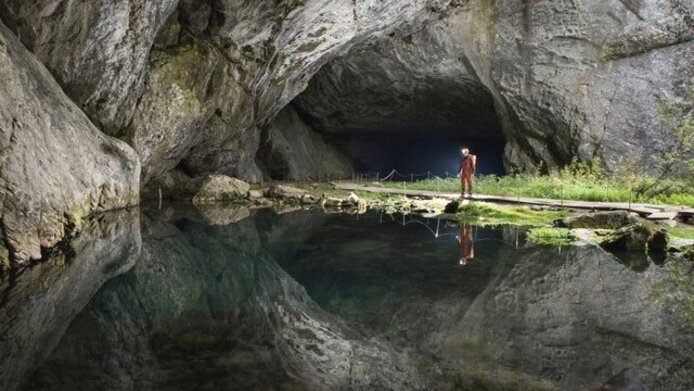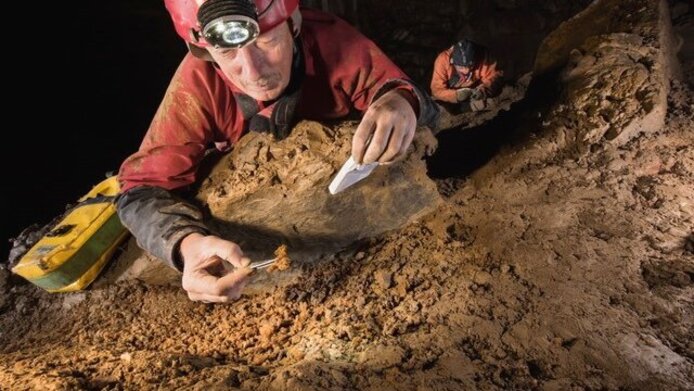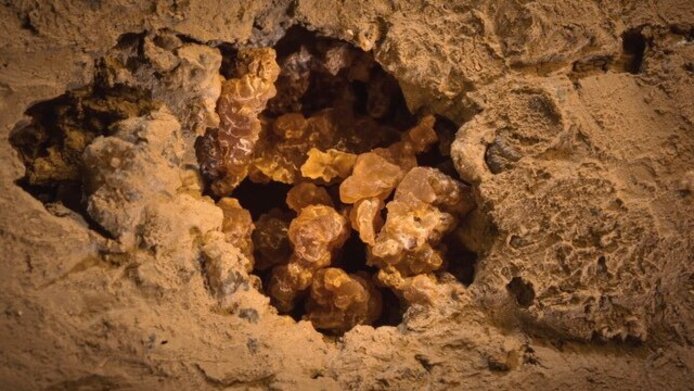Frost-produced crystals as permafrost markers

Exploring natural “archives” furnishes insights into the Earth’s climate past, the so-called palaeoclimate. Among such archives calcareous deposits growing inside caves (also known as speleothems) stand out. On one hand they “record” the isotopic composition of the oxygen and carbon of the former rainwater, which allows reconstruction of climatic and environmental conditions of the past. On another – they can be precisely and accurately dated by uranium-thorium method over the past 500,000 years. While not accorded much attention in the past, a special type of speleothems, cryogenic cave carbonates (CCCs), have recently been recognized as a valuable marker of climate variability. CCC crystals are formed at just below zero degrees Celsius. In slowly freezing water, concentration of dissolved ions increases, as these ions are rejected by the growing ice mass. Ultimately, calcium carbonate begins to crystallize out of this residual water and form millimetre to centimetre-sized aggregates. Since the temperature deep inside the cave closely corresponds to mean annual temperature on the surface, CCCs are thus indicators of the former presence of permafrost. Because the Ural Mountains run from north to south, suitable samples from karst caves in this mountain range can be used to reconstruct the north-south movements of the permafrost boundary in this part of Eurasia over the past half million years.
Helping hands and trained eyes
Yuri Dublyansky, a geologist and geochemist in the University of Innsbruck’s Quaternary Research Group, has spent 20 years working at the Siberian branch of the Russian Academy of Sciences in Novosibirsk. His connections and language skills paved the way for the Russian-Austrian cooperation project in the Urals, which was supported by the Austrian Science Fund FWF. Sampling in such remote and poorly accessible terrain would not have been possible without active support of local scientists and cavers. The search for the inconspicuous CCC crystals in dark caves required many helping hands, permits, special equipment, a trained eye and geological expertise. The teams went looking for samples in 40 caves, some of them remote and protected, and found what they were looking for in only nine of them. They then performed uranium-thorium dating in cooperation with institutions in China and the USA to determine accurately the age of the individual crystals and, by extension, the time when permafrost was present at these locations.

Big changes and faster fluctuations
The geologist describes the results available so far as mere scratches on the surface: “CCCs are an important marker, but they turned to be more sensitive and sometimes more complex than previously thought. The data not only record major swings from glacial to interglacial climates in the Urals. We're also starting to see permafrost responding to minor temperature variations associated with shorter-scale climate changes.” The data imply that the southern boundary of permafrost almost reached the Caspian Sea during peak cold climatic periods. “In some caves we found several generations of CCC, which tells us that these caves saw permafrost at different times in the past. Other palaeoclimate archives cannot offer such precise insights,” says Yuri Dublyansky. There was clear proof of the last ice age about 25,000 years ago provided by the CCC finds in the South Urals. But there is also evidence of permafrost during the period between 37,000 and about 48,000 years ago. A research approach of particular interest combines CCC with “common” speleothems, e.g., stalagmites in one and the same cave: the former indicate cold (permafrost) conditions, while stalagmites form during warmer climatic phases.
Frosty works of art
In the course of filed work, Yuri Dublyansky also visited the Shulgan-Tash Cave in Southern Ural were found 60 years ago, making it the easternmost cave art site in Europe. Based on earlier radiocarbon dating of charcoal from the cultural layer in the cave, the famous depictions of mammoths and a two-humped camel were made between about 16,000 to 19,000 years ago. These dates were corroborated by Dublyansky’s group uranium-thorium dating of flowstone on which paintings were made and by which they were later overgrown. Dublyansky concluded: “Considering ages of the paintings in context of our permafrost reconstructions, we can say that these works of art were made deep in the belly of a dark cave when the temperature there was below freezing point. To our knowledge, this situation is unique among all known decorated Palaeolithic cave sites.”
Personal details Yuri Dublyansky has held a position at the Institute of Geology at the University of Innsbruck since 2006; he has been researching formations in karst caves since the 1990s. From 2003 to 2006 he worked at the Museo Tridentino di Scienze Naturali (Trento, Italy) to develop new methods and techniques for palaeoclimate studies and was previously involved in the geological evaluation of planned nuclear waste deposit sites in Nevada (USA) and Novaya Zemlya (Russia). His research focuses on isotopic geochemistry, fluid inclusions in crystals, cave formation, and palaeohydrology.
Publications






